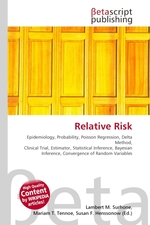Relative Risk
Lambert M. Surhone, Miriam T. Timpledon, Susan F. Marseken
бумажная книга
High Quality Content by WIKIPEDIA articles! In statistics and mathematical epidemiology, relative risk (RR) is the risk of an event (or of developing a disease) relative to exposure. Relative risk is a ratio of the probability of the event occurring in the exposed group versus a non-exposed group.[1] RR= frac {p_text{exposed}}{p_text{non-exposed}} Consider an example where the probability of developing lung cancer among smokers was 20% and among non-smokers 1%. This situation is expressed in the 2 x 2 table to the right. Risk Disease status Present Absent Smk a b Non-smk c d Here, a = 20(%), b = 80, c = 1, and d = 99. Then the relative risk of cancer associated with smoking would be RR=frac {a/(a+b)}{c/(c+d)} = frac {20/100}{1/100} = 20. Smokers would be twenty times as likely as non-smokers to develop lung cancer.
Данное издание не является оригинальным. Книга печатается по технологии принт-он-деманд после получения заказа.


